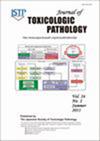桔梗水提物诱导大鼠胃鳞状细胞增生过程中Caspase-3和Ki-67的表达
IF 0.9
4区 医学
Q4 PATHOLOGY
引用次数: 2
摘要
桔梗在传统中药中被广泛用于治疗支气管炎、哮喘、肺结核、高血压、高脂血症和糖尿病。本研究的目的是在亚慢性毒性研究中探讨桔黄水提取物诱导胃鳞状细胞增生的细胞增殖(Ki-67)和凋亡(Caspase-3)潜能。取100只经福尔马林固定、石蜡包埋的大鼠胃组织,分别以0、500、1000、3000 mg/kg体重/天的剂量给药。用苏木精和伊红(H&E)常规染色,用caspase-3和Ki-67抗体免疫组织化学(IHC)染色。3000 mg/kg体重/天处理组鳞状细胞增生的发生率显著高于对照组(p<0.01)。恢复期4周后,增生性改变完全修复。Ki-67在各组间表达相似,组间差异无统计学意义。在3000 mg/kg体重/天处理组中,Caspase-3的表达量与对照相比显著升高(p<0.01),在恢复组中,Caspase-3的表达量降至正常水平。综上所述,本研究认为桔梗水提物诱导的胃限定脊鳞状细胞增生不属于异常增生性改变;因此,在大鼠中,每天口服一次桔梗水提取物,连续13周诱导鳞状细胞增生,被认为是非不良反应。本文章由计算机程序翻译,如有差异,请以英文原文为准。
Evaluation of Caspase-3 and Ki-67 expression in squamous cell hyperplasia of the stomach induced by Platycodi radix water extract in Sprague–Dawley rats
Platycodi radix is widely used in traditional herbal medicine for the treatment of bronchitis, asthma, pulmonary tuberculosis, hypertension, hyperlipidemia, and diabetes. This study aimed to investigate cell proliferation (Ki-67) and apoptosis (Caspase-3) potential in squamous cell hyperplasia of the stomach induced by a Platycodi radix water extract in a subchronic toxicity study. One hundred formalin-fixed, paraffin-embedded stomach tissues of rats treated with Platycodi radix at doses of 0, 500, 1,000, and 3,000 mg/kg body weight/day were used for the analysis. They were conventionally stained using hematoxylin and eosin (H&E) and immunohistochemically (IHC) stained using caspase-3 and Ki-67 antibodies. The incidence of squamous cell hyperplasia was significantly increased in the 3,000 mg/kg b.w./day treatment group in both sexes (p<0.01). However, the hyperplastic change was completely repaired after 4 weeks of recovery period. Ki-67 expression was similar in all groups, with no statistically significant differences among the groups. Caspase-3 expression was significantly increased in both sexes in the 3,000 mg/kg b.w./day treatment group (p<0.01), compared with the vehicle control groups, and then reduced to normal levels in the recovery groups in both sexes. In conclusion, this study showed that squamous cell hyperplasia induced by the Platycodi radix water extract in the limiting ridge of the stomach is not considered to be abnormal proliferative change; as a result, squamous cell hyperplasia is considered to be a non-adverse effect when induced by the oral administration of the Platycodi radix water extract once daily for 13 weeks in rats.
求助全文
通过发布文献求助,成功后即可免费获取论文全文。
去求助
来源期刊

Journal of Toxicologic Pathology
PATHOLOGY-TOXICOLOGY
CiteScore
2.10
自引率
16.70%
发文量
22
审稿时长
>12 weeks
期刊介绍:
JTP is a scientific journal that publishes original studies in the field of toxicological pathology and in a wide variety of other related fields. The main scope of the journal is listed below.
Administrative Opinions of Policymakers and Regulatory Agencies
Adverse Events
Carcinogenesis
Data of A Predominantly Negative Nature
Drug-Induced Hematologic Toxicity
Embryological Pathology
High Throughput Pathology
Historical Data of Experimental Animals
Immunohistochemical Analysis
Molecular Pathology
Nomenclature of Lesions
Non-mammal Toxicity Study
Result or Lesion Induced by Chemicals of Which Names Hidden on Account of the Authors
Technology and Methodology Related to Toxicological Pathology
Tumor Pathology; Neoplasia and Hyperplasia
Ultrastructural Analysis
Use of Animal Models.
 求助内容:
求助内容: 应助结果提醒方式:
应助结果提醒方式:


